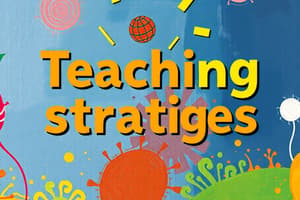Podcast
Questions and Answers
What is the primary focus of direct instruction as an educational strategy?
What is the primary focus of direct instruction as an educational strategy?
- Engaging students in real-world projects
- Encouraging students to explore topics independently
- Fostering collaboration among students
- Explicit teaching of concepts by the teacher (correct)
Which educational strategy is characterized by students working together in groups?
Which educational strategy is characterized by students working together in groups?
- Project-Based Learning
- Collaborative Learning (correct)
- Inquiry-Based Learning
- Differentiated Instruction
What is a key benefit of differentiated instruction?
What is a key benefit of differentiated instruction?
- Alignment with standardized curriculum
- Addressing diverse learning styles and needs (correct)
- Promoting individual competition among students
- Limiting resource requirements for teachers
Which component of educational strategies involves providing constructive responses to student work?
Which component of educational strategies involves providing constructive responses to student work?
What challenge is commonly associated with implementing effective educational strategies?
What challenge is commonly associated with implementing effective educational strategies?
What is a key benefit of using questioning in education?
What is a key benefit of using questioning in education?
Which type of question is designed to elicit specific factual answers?
Which type of question is designed to elicit specific factual answers?
How does Bloom's Taxonomy assist in question development?
How does Bloom's Taxonomy assist in question development?
What is a key characteristic of Socratic Questioning?
What is a key characteristic of Socratic Questioning?
What strategy can be used to relate questions to real-world scenarios?
What strategy can be used to relate questions to real-world scenarios?
Which assessment technique aids in understanding students’ comprehension?
Which assessment technique aids in understanding students’ comprehension?
What is an important aspect of encouraging student-generated questions?
What is an important aspect of encouraging student-generated questions?
How should teachers handle the quality of questions posed by students?
How should teachers handle the quality of questions posed by students?
Flashcards are hidden until you start studying
Study Notes
Summary of Educational Strategies
-
Definition: Educational strategies are planned methods and techniques used to facilitate learning and improve educational outcomes.
-
Types of Educational Strategies:
- Direct Instruction: Teacher-centered approach focusing on explicit teaching of concepts.
- Collaborative Learning: Students work together in groups to enhance understanding and retention.
- Project-Based Learning: Engages students in real-world projects to apply knowledge and skills.
- Inquiry-Based Learning: Encourages students to ask questions and explore topics through investigation.
- Differentiated Instruction: Tailoring teaching methods to meet the diverse needs of students.
-
Key Components:
- Goal Setting: Clearly defined learning objectives.
- Assessment: Ongoing evaluation of student progress to inform instruction.
- Feedback: Constructive responses to student work to promote improvement.
- Engagement: Techniques to motivate and involve students in the learning process.
-
Benefits:
- Enhances student motivation and engagement.
- Improves retention of information.
- Fosters critical thinking and problem-solving skills.
- Prepares students for real-life applications of knowledge.
-
Challenges:
- Requires adaptation to various learning styles and needs.
- May demand more resources and teacher training.
- Balancing curriculum requirements with innovative strategies.
-
Best Practices:
- Integrate technology to enhance learning experiences.
- Foster a supportive classroom environment.
- Encourage student voice and choice in learning activities.
- Use data-driven decision making to evaluate strategy effectiveness.
Educational Strategies Overview
- Educational strategies consist of intentional methods designed to enhance learning outcomes for students.
Types of Educational Strategies
- Direct Instruction: A structured, teacher-centric method where concepts are explicitly taught to students.
- Collaborative Learning: Students engage in teamwork, promoting deeper understanding and retention through group activities.
- Project-Based Learning: Involves students in hands-on projects that require the application of knowledge and skills to real-world scenarios.
- Inquiry-Based Learning: Students are motivated to investigate questions and explore topics independently, fostering a sense of curiosity.
- Differentiated Instruction: Adapts teaching styles and techniques to address the varied needs of individual students.
Key Components of Educational Strategies
- Goal Setting: Establishes clear, specific learning objectives for students to achieve.
- Assessment: Utilizes ongoing evaluations to track student progress and guide instructional adjustments.
- Feedback: Provides constructive and timely responses to student work, helping them to improve over time.
- Engagement: Employs diverse motivational techniques to keep students actively involved in their learning journey.
Benefits of Educational Strategies
- Increases student motivation and engagement, leading to a more dynamic learning environment.
- Enhances retention of information by incorporating active learning methods.
- Develops critical thinking and problem-solving abilities essential for future challenges.
- Prepares students for practical applications of their knowledge in real-life contexts.
Challenges in Implementing Educational Strategies
- Necessitates adjustment to accommodate various learning styles and individual student needs.
- May require additional resources and training for teachers to effectively execute diverse strategies.
- Balancing traditional curriculum requirements while incorporating innovative teaching practices can be difficult.
Best Practices for Effective Educational Strategies
- Integrate technology into lesson plans to enrich learning experiences and accessibility.
- Create a nurturing classroom atmosphere that encourages student participation and safety.
- Empower students by allowing them choices in their learning processes and activities.
- Utilize data-driven approaches to assess the impact and effectiveness of educational strategies continuously.
Purpose of Questioning in Education
- Stimulates critical thinking and engages students in learning.
- Encourages a deeper understanding of educational material.
- Assists teachers in assessing student comprehension.
Types of Questions
-
Open-ended Questions
- Foster discussion and exploration of topics.
- Example: "What are the implications of climate change on global agriculture?"
-
Closed-ended Questions
- Require specific, concise factual answers.
- Example: "What is the capital of France?"
-
Higher-order Questions
- Promote analysis, evaluation, and synthesis of information.
- Example: "How would you evaluate the effectiveness of renewable energy policies?"
Strategies for Developing Questions
-
Bloom’s Taxonomy
- Utilize levels (remember, understand, apply, analyze, evaluate, create) as a framework for question creation.
-
Think-Pair-Share
- Students think independently, pair up for discussion, and then share insights with the larger group.
-
Socratic Questioning
- Employ probing inquiries to challenge assumptions and deepen thought processes.
-
Creating Contextual Questions
- Link questions to real-world scenarios for enhanced relevance.
- Example: "How does the concept of supply and demand affect daily consumer choices?"
Assessment through Questioning
- Implement formative assessments to monitor and gauge student understanding.
- Use a mixture of question types to evaluate various skills and competencies.
Encouraging Student-generated Questions
- Cultivate an environment where students feel comfortable asking their own questions.
- Conduct brainstorming sessions to collaboratively generate topic-related inquiries.
Feedback on Questioning
- Provide constructive feedback on the quality and clarity of student questions.
- Encourage the revision and refinement of questions to improve depth and focus.
Reflection on Questioning Techniques
- Regularly evaluate the effectiveness of questioning strategies in the classroom.
- Adapt questioning techniques based on student responses and levels of engagement.
Studying That Suits You
Use AI to generate personalized quizzes and flashcards to suit your learning preferences.




